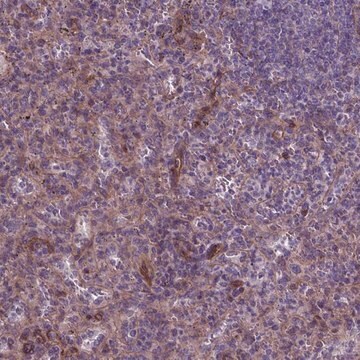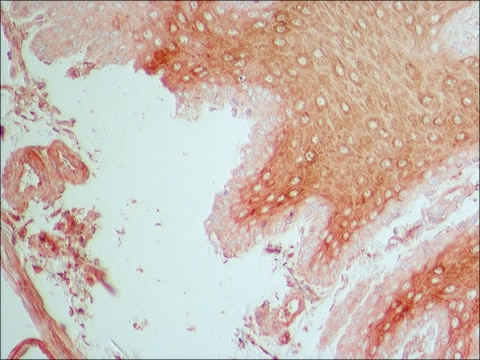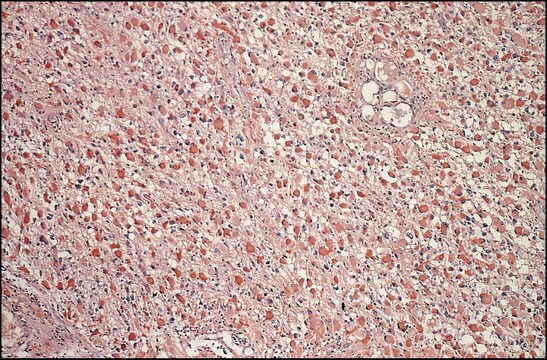추천 제품
생물학적 소스
mouse
Quality Level
결합
unconjugated
항체 형태
purified antibody
항체 생산 유형
primary antibodies
클론
9D9F9, monoclonal
분자량
calculated mol wt 152.76 kDa
observed mol wt ~190 kDa
정제법
using protein G
종 반응성
human
포장
antibody small pack of 100 μL
기술
immunocytochemistry: suitable
immunohistochemistry (formalin-fixed, paraffin-embedded sections): suitable
immunoprecipitation (IP): suitable
western blot: suitable
동형
IgG1
에피토프 서열
Extracellular domain
단백질 ID 수납 번호
UniProt 수납 번호
배송 상태
2-8°C
타겟 번역 후 변형
unmodified
유전자 정보
human ... FLT4(2324)
일반 설명
Vascular endothelial growth factor receptor 3 (UniProt: P35916; also known as EC:2.7.10.1, VEGFR-3, Fms-like tyrosine kinase 4, FLT-4, Tyrosine-protein kinase receptor FLT4) is encoded by the FLT4 (also known as VEGFR3) gene (Gene ID: 2324) in human. FLT-4 is a single-pass type I membrane glycoprotein that is synthesized with a signal peptide (aa 1-24), which is subsequently cleaved off to generate the mature form that contains an extracellular domain (aa 25-775), a transmembrane domain (aa 776-796), and cytoplasmic domain (aa 797-1363). It is expressed in endothelial cells and is also detected in fetal spleen, lung, and brain. In adults it is detected in liver, muscle, thymus, placenta, lung, testis, ovary, prostate, heart, and kidney. FLT-4 has tyrosine-protein kinase activity and acts as a receptor for VEGFC and VEGFD. It plays a role in adult lymphangiogenesis and in the development of the vascular network and the cardiovascular system during embryonic development. Its secreted form functions as a decoy receptor for VEGFC and/or VEGFD and play an important role as a negative regulator of VEGFC-mediated lymphangiogenesis and angiogenesis. Its major function is to promote proliferation, survival, and migration of endothelial cells, and regulates angiogenic sprouting. FLT-4 undergoes trans auto-phosphorylation on tyrosine residues upon ligand binding. Phosphorylation at tyrosine 1068 is required for autophosphorylation at additional tyrosine residues. Phosphorylation at tyrosine 1063 and 1337 are important for interaction with Crk adaptor proteins and subsequent activation of MAPK8. In addition, its phosphorylation at tyrosine 1230, 1231, and 1337 are reported to be important for interaction with Grb2 and subsequent activation of the AKT1 and ERK1/ERK2 signaling pathways.
특이성
Clone 9D9F9 is a mouse monoclonal antibody that detects Vascular endothelial growth factor receptor 3 (VEGFR-3). It targets an epitope within the extracellular domain.
면역원
A recombinant fragment corresponding to the extracellular domain of human Vascular endothelial growth factor receptor 3 (VEGFR-3).
애플리케이션
Quality Control Testing
Evaluated by Western Blotting in lysate from HEK293 cells over-expressing VEGFR-3.
Western Blotting Analysis (WB): A 1:500 dilution of this antibody detected Vascular endothelial growth factor receptor 3 (VEGFR-3) in lysate from HEK293 cells over-expressing human VEGFR-3.
Tested Applications
Immunoprecipitation Analysis: A representative lot immunoprecipitated VEGF Receptor-3 in Immunoprecipitation applications (Bando, H., et al. (2004). Int J Cancer; 111(2):184-91).
ELISA Analysis: A representative lot detected VEGF Receptor-3 in ELISA applications (Bando, H., et al. (2004). Int J Cancer; 111(2):184-91).
Immunohistochemistry (Paraffin) Analysis: A 1:250 dilution from a representative lot detected VEGF Receptor-3 in human placenta and human kidney tissue sections.
Western Blotting Analysis: A representative lot detected VEGF Receptor-3 in Western Blotting applications (Bando, H., et al. (2004). Int J Cancer; 111(2):184-91; Zhang, Y., et al. (2018). Nat Commun.; 9(1):1296).
Immunohistochemistry Applications: A representative lot detected VEGF Receptor-3 in Immunohistochemistry applications (Bando, H., et al. (2004). Int J Cancer; 111(2):184-91; Jussila, L. et al. (1998). Cancer Res.; 58(8):1599-604; Su, C., et al. (2011). J Exp Clin Cancer Res.; 30(1):85; Valtola, R., et al. (1999). Am J. Pathol.; 154(5):1381-90).
Immunocytochemistry Analysis: A 1:100 dilution from a representative lot detected VEGF Receptor-3 in human umbilical vascular endothelial cells (HUVEC).
Note: Actual optimal working dilutions must be determined by end user as specimens, and experimental conditions may vary with the end user
Evaluated by Western Blotting in lysate from HEK293 cells over-expressing VEGFR-3.
Western Blotting Analysis (WB): A 1:500 dilution of this antibody detected Vascular endothelial growth factor receptor 3 (VEGFR-3) in lysate from HEK293 cells over-expressing human VEGFR-3.
Tested Applications
Immunoprecipitation Analysis: A representative lot immunoprecipitated VEGF Receptor-3 in Immunoprecipitation applications (Bando, H., et al. (2004). Int J Cancer; 111(2):184-91).
ELISA Analysis: A representative lot detected VEGF Receptor-3 in ELISA applications (Bando, H., et al. (2004). Int J Cancer; 111(2):184-91).
Immunohistochemistry (Paraffin) Analysis: A 1:250 dilution from a representative lot detected VEGF Receptor-3 in human placenta and human kidney tissue sections.
Western Blotting Analysis: A representative lot detected VEGF Receptor-3 in Western Blotting applications (Bando, H., et al. (2004). Int J Cancer; 111(2):184-91; Zhang, Y., et al. (2018). Nat Commun.; 9(1):1296).
Immunohistochemistry Applications: A representative lot detected VEGF Receptor-3 in Immunohistochemistry applications (Bando, H., et al. (2004). Int J Cancer; 111(2):184-91; Jussila, L. et al. (1998). Cancer Res.; 58(8):1599-604; Su, C., et al. (2011). J Exp Clin Cancer Res.; 30(1):85; Valtola, R., et al. (1999). Am J. Pathol.; 154(5):1381-90).
Immunocytochemistry Analysis: A 1:100 dilution from a representative lot detected VEGF Receptor-3 in human umbilical vascular endothelial cells (HUVEC).
Note: Actual optimal working dilutions must be determined by end user as specimens, and experimental conditions may vary with the end user
Anti-VEGF Receptor-3, clone 9D9F9, Cat. No. MAB3757-I, is a mouse monoclonal antibody that detects VEGF receptor 3 and is tested for use in ELISA, Immunocytochemistry, Immunohistochemistry (Paraffin), Immunoprecipitation, and Western Blotting.
물리적 형태
Purified mouse monoclonal antibody IgG1 in buffer containing 0.1 M Tris-Glycine (pH 7.4), 150 mM NaCl with 0.05% sodium azide.
저장 및 안정성
Recommend storage at +2°C to +8°C. For long term storage antibodies can be kept at -20°C. Avoid repeated freeze-thaws.
기타 정보
Concentration: Please refer to the Certificate of Analysis for the lot-specific concentration.
면책조항
Unless otherwise stated in our catalog or other company documentation accompanying the product(s), our products are intended for research use only and are not to be used for any other purpose, which includes but is not limited to, unauthorized commercial uses, in vitro diagnostic uses, ex vivo or in vivo therapeutic uses or any type of consumption or application to humans or animals.
Not finding the right product?
Try our 제품 선택기 도구.
Storage Class Code
12 - Non Combustible Liquids
WGK
WGK 1
Flash Point (°F)
Not applicable
Flash Point (°C)
Not applicable
시험 성적서(COA)
제품의 로트/배치 번호를 입력하여 시험 성적서(COA)을 검색하십시오. 로트 및 배치 번호는 제품 라벨에 있는 ‘로트’ 또는 ‘배치’라는 용어 뒤에서 찾을 수 있습니다.
자사의 과학자팀은 생명 과학, 재료 과학, 화학 합성, 크로마토그래피, 분석 및 기타 많은 영역을 포함한 모든 과학 분야에 경험이 있습니다..
고객지원팀으로 연락바랍니다.








